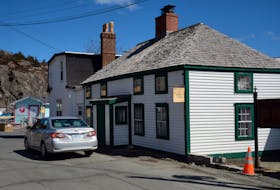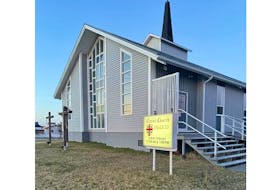A four-cannon battery that was installed by the British to defend the community of St. Mary’s and protect the Newfoundland fishery in the late 1700s is being restored by a local committee with plans to turn the area into an interpretative park and draw more visitors to the town.
David Fagan, chairman of the St. Mary’s Queen’s Battery Restoration Committee, says excitement is building about the restoration plans and the committee hopes to celebrate Canada Day events at the park this summer.
“The battery went into service in 1779 and ended its commission in 1815,” Fagan said. “Research shows that it was the only battery to have been actively engaged during the years of the War of American Independence (1775-83), capturing an American privateer in 1782.”
American privateers were quite active during the war against the British, and disrupting the migratory fishery in Newfoundland was a key target.
Only one of the original cannons remains in place at the St. Mary’s battery site — an area known locally as The Point. That cannon is weathered and worn, but is still in relatively good shape. The three other cannons are presumed to have ended up in the ocean — either falling from their mounts some years ago due to the corrosion of the shoreline, or being taken and used as ballast for wharf construction in the late 1800s.
There are local stories passed down that after the wharf was torn apart by storms, the cannons ended up somewhere among the rubble on the bottom. One cannon is said to have, over time, been driven by the sea onto a nearby shore. Some say a fishing vessel was seen some years ago using its boom to lift it onboard and take it away.
A preliminary search for the other two cannons has not yielded any results.
Fagan said provincial archeologists advised them, however, to leave the cannons where they are, even if they discover their location.
“After being in the salt water that long, exposure to the air will cause them to quickly corrode,” Fagan said.
He said the committee has been searching for other cannons in the province that are not on display. If they are unsuccessful, he said, they will get replicas made.
The battery at St. Mary’s was one of seven small batteries built on the Avalon Peninsula at the time. The others were located at Bay Bulls, Ferryland, Fermeuse, Renews, Trepassey and Petty Harbour.
Olaf Janzen, a retired professor of history at Memorial University’s Grenfell Campus, said the decision to provide those outports with the means of self-defence against American privateers was made in the summer of 1778 by Newfoundland governor John Montagu — although the idea had already surfaced before then. Capt. Robert Pringle of the Royal Corps of Engineers had favoured arming the outports as part of a plan he had submitted to the Board of Ordnance in 1773 for the defence of the fishery.
“The actual implementation of the idea had to wait until the following year, by which time Richard Edwards had replaced John Montagu as governor,” Janzen said.
Janzen has written numerous papers on Newfoundland history, including his PhD dissertation, “Newfoundland and British Maritime Strategy During the American Revolution.”
In his dissertation, Janzen notes Montagu concluded that the only defence possible was to arm the outports with small batteries and to train local volunteers to man them.
“In 1779, Trepassey and St. Mary’s each received four 9-pounders,” Janzen noted.
Committee member Peter Buiteman said research further shows that the cannons at the battery in St. Mary’s came from the British naval ship HMS Proteus at St. John’s harbour, which had become unfit for service due to its rundown condition.
He said the Proteus had been a 26-gun ship, and the committee has obtained a copy of its logbook.
Buiteman also referred to a memo from Edwards at the time that ordered “that a gunner and a matross (gunner’s assistant) be sent to St. Mary’s to assist in defending the same and to take care of the cannon and ordinance stores.”
Fagan notes that research shows the battery was used in the capture of the privateer Hazard on Sept. 16, 1782. The committee has obtained a copy of the letter written by then Newfoundland governor John Campbell regarding the capture.
The letter, dated Oct. 2, 1782, thanks the people at St. Mary’s for “your very spirited conduct in taking the Hazard, privateer.”
It further asked the recipient of the letter to “inform the inhabitants and others who so bravely assisted you upon the occasion, that I very much approve of their conduct and cheerfully resign all right of title to the prize, which I hope will be disposed of to the satisfaction of everybody concerned.”
Fagan noted the letter, and other documents the committee has obtained, will make up the history that will be told on storyboards at the park.
In addition to storyboards, cannons or replicas of cannons, and other items to restore the park, the committee will eventually work on opening an interpretation centre and museum, and link hiking trails to other attractions at neighbouring communities.
A number of artifacts were uncovered during an archeological dig of the site in 2000 led by archeologist Douglas Nixon. The artifacts — including clay pipes, coins and buttons — are on display at The Rooms in St. John’s.
And come July, while the cannons will once again be pointed toward the sea as a symbolic protection of the approach to St. Mary’s, they won’t fire in anger as they did more than 200 years ago. However, there may be another type of cannon fire.
“There are a few potato cannons in the community,” Fagan said. “We are looking into it to see if we can incorporate them into our opening, a kind of potato cannon target contest.”








